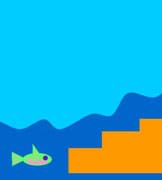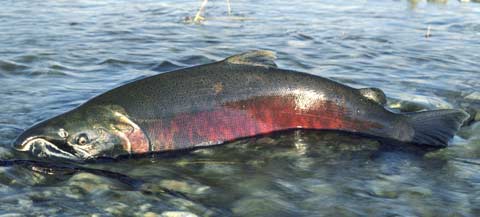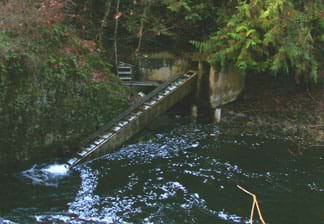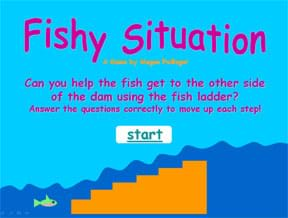Quick Look
Grade Level: 4 (3-5)
Time Required: 30 minutes
Expendable Cost/Group: US $0.00
Group Size: 1
Activity Dependency: None
Subject Areas: Biology, Earth and Space, Geometry, Life Science, Measurement, Physical Science, Problem Solving, Science and Technology
NGSS Performance Expectations:

| 5-ESS3-1 |
Summary
Students further their understanding of the salmon life cycle and the human structures and actions that aid in the migration of fish around hydroelectric dams by playing an animated PowerPoint game involving a fish that must climb a fish ladder to get over a dam. They first brainstorm their own ideas, and then learn about existing ways engineers have made dams "friendlier" to migrating fish, before being quizzed as part of the game.
Engineering Connection
Building dams results in many advantages for humans, and often many disadvantages for wildlife in nearby ecosystems. Getting a living animal past a dam without disrupting its life cycle need to swim upstream to breed is a challenging problem. Engineers are called upon to address this problem and they've come up with many different fish mitigation approaches that better protect the fish that migrate up and down rivers as part of their natural life cycles. Engineers use brainstorming techniques to help them create different and better solutions.
Learning Objectives
After this activity, students should be able to:
- Demonstrate a basic knowledge of the salmon life cycle.
- List the impediments that dams pose to salmon migration.
- Identify three types of structures that engineers have designed to assist salmon in migrating through, over and around hydroelectric dams
Educational Standards
Each TeachEngineering lesson or activity is correlated to one or more K-12 science,
technology, engineering or math (STEM) educational standards.
All 100,000+ K-12 STEM standards covered in TeachEngineering are collected, maintained and packaged by the Achievement Standards Network (ASN),
a project of D2L (www.achievementstandards.org).
In the ASN, standards are hierarchically structured: first by source; e.g., by state; within source by type; e.g., science or mathematics;
within type by subtype, then by grade, etc.
Each TeachEngineering lesson or activity is correlated to one or more K-12 science, technology, engineering or math (STEM) educational standards.
All 100,000+ K-12 STEM standards covered in TeachEngineering are collected, maintained and packaged by the Achievement Standards Network (ASN), a project of D2L (www.achievementstandards.org).
In the ASN, standards are hierarchically structured: first by source; e.g., by state; within source by type; e.g., science or mathematics; within type by subtype, then by grade, etc.
NGSS: Next Generation Science Standards - Science
| NGSS Performance Expectation | ||
|---|---|---|
|
5-ESS3-1. Obtain and combine information about ways individual communities use science ideas to protect the Earth's resources and environment. (Grade 5) Do you agree with this alignment? |
||
| Click to view other curriculum aligned to this Performance Expectation | ||
| This activity focuses on the following Three Dimensional Learning aspects of NGSS: | ||
| Science & Engineering Practices | Disciplinary Core Ideas | Crosscutting Concepts |
| Obtain and combine information from books and/or other reliable media to explain phenomena or solutions to a design problem. Alignment agreement: | Human activities in agriculture, industry, and everyday life have had major effects on the land, vegetation, streams, ocean, air, and even outer space. But individuals and communities are doing things to help protect Earth's resources and environments. Alignment agreement: | A system can be described in terms of its components and their interactions. Alignment agreement: Science findings are limited to questions that can be answered with empirical evidence.Alignment agreement: |
International Technology and Engineering Educators Association - Technology
-
The use of technology affects the environment in good and bad ways.
(Grades
3 -
5)
More Details
Do you agree with this alignment?
-
Identify and collect information about everyday problems that can be solved by technology, and generate ideas and requirements for solving a problem.
(Grades
3 -
5)
More Details
Do you agree with this alignment?
State Standards
Colorado - Science
-
Create and evaluate models of the flow of nonliving components or resources through an ecosystem
(Grade
4)
More Details
Do you agree with this alignment?
-
Make a plan to positively impact a local ecosystem
(Grade
4)
More Details
Do you agree with this alignment?
Materials List
Each group needs:
- Computer with Microsoft PowerPoint software application
Worksheets and Attachments
Visit [www.teachengineering.org/activities/view/cub_dams_lesson06_activity1] to print or download.Pre-Req Knowledge
A familiarity with the natural life cycle of salmon and many ways of protecting fish migration through dams, as introduced in lesson 6 of the Dams unit.
Introduction/Motivation
Can anyone tell me: Why can't we just build a dam and leave the ecosystem alone? (Take suggestions from students.) Well, by building a dam, we are disrupting the ecosystem. Who can remember a specific part of the ecosystem that we disrupt by building dams? (Take suggestions from students.) Think of the salmon life cycle. Do you remember that adult salmon must swim upstream in a river to spawn (to lay eggs)? If a dam blocks the river, how will salmon get past it to continue swimming upstream to their birthplace to lay their eggs? Another thing to consider is that the turbines in every dam (they generate electric power when water spins their blades) can spin very, very fast, often harming or killing the younger fish who are swimming downstream towards the ocean.
Now that you realize these fish hazards, how would you make a dam more fish friendly? Engineers incorporate into their new dam designs (and modify existing dams with) devices, structures and human actions that protect and help the migrating salmon in a river. Let's brainstorm to think about how we could protect fish swimming both upstream and downstream. (Lead a class brainstorming session; see details in the Assessment section.)
Engineers have already designed many devices to help fish. Examples include:
- Fish ladders (a series of steps up the vertical distance of the dam; fish ladders mimic a series of low, natural waterfalls, which is something that salmon are able to navigate by leaping)
- Fish elevators or fish lifts (a mechanical way to raise fish up from the bottom of a dam to the top part of the reservoir so they can continue to swim upstream)
- Turbine intake screens (screens that let the water go through but prevent downstream-swimming fish from getting pulled into the turbines)
- Turbine intake racks (steel cage-like structures that prevent downstream-swimming fish [as well as trash and debris] from getting caught in turbine intakes)
- Sound/light/bubble diversion devices (devices that emit underwater sound, light and/or bubbles as "behavioral barriers" to scare fish away from turbine intakes)
- Bypass barges (big flat boats that collect and transport fish over a dam through a lock system, releasing them downstream from the dam)

Let's discuss how each of these devices works and how it protects and helps the fish passing through the dam. Can anyone think of another way to help fish cross a dam?
Engineers consider the effects on nearby ecosystems and design dams that minimize the harm to plants and animals. To figure out good ways to help salmon get past a dam, engineers must know all about the salmon's life cycle as well as the many solutions that are already being used. So today, we are going to play a fun trivia game that will also make sure that we have enough expertise to design the best dam for the ecosystem around Birdseye River.
Procedure
Before the Activity
- Set up the game on each computer by opening up the Fishy Situation Game PowerPoint file.
- If conducting the Vocabulary Dance assessment activity, prepare the cards following instructions in the Assessment section.
With the Students
- Alert students to make notes while they play of at least three terms from the game that they do not recognize or fully understand.
- With the PowerPoint file open and on the first slide, have students choose "Slide Show" > "From Beginning."

In the Fishy Situation game, you help salmon swim up a fish ladder. - Direct students to use the buttons to navigate and answer the questions.
- After finishing the game, have students use the "Esc" key to exit the game, and then close PowerPoint.
- As a class, conclude by handing out cards printed with vocabulary terms and definitions for a post-activity Vocabulary Dance assessment, as described in the Assessment section.
- Assign students to research their unknown/uncertain game terms by using the Internet to find descriptions, images and photos, as described in the Assessment section.
Vocabulary/Definitions
adult (salmon): Term used to describe a salmon that is fully developed. Adult salmon swim upstream to their spawning grounds.
anadromous: Type of fish that migrate from salt water to breed in fresh water.
engineer: A person who applies her/his understanding of science and math to creating things for the benefit of humanity and our world.
fish ladder: A device used to aid in the upstream migration of an adult salmon over a dam.
juvenile (salmon): Term used to describe a salmon that is not yet fully developed. Juvenile salmon are swim downstream to the ocean where they will become adults.
migration: A round-trip voyage that salmon embark on from their birthplace in their home streams out to the ocean and back again to spawn.
smolt: A fish that has not yet reached the juvenile stage. Smolts undergo body changes that enable them to survive in salty ocean water.
spawn: The reproductive process of salmon. Spawning females deposit eggs in gravel nests in streams where the eggs are fertilized by adult males.
spillway: The part of a dam where water from the upstream reservoir "spills" into the tailrace.
tailrace: The downstream portion of a dam.
Assessment
Pre-Activity Assessment
Discussion/Brainstorming: As a class, have students engage in open discussion. Remind students that in brainstorming, no idea or suggestion is "silly." All ideas should be respectfully heard. Take an uncritical position, encourage wild ideas and discourage criticism of ideas. Have them raise their hands to respond. Record their ideas on the board. Ask the students:
- How would you make a dam more fish-friendly? What might help fish swim safely downstream and through a dam? What might help fish swim upstream and over a dam? (Possible answers: Fish ladders, fish elevators, intake screens, intake racks, sound/light/bubble diversion devices, bypass barges, bypass channels, water slides, or any creative ideas that the students think of on their own.)
Activity Embedded Assessment
Research Assignment, Part 1: In advance of playing the game, alert students to make a note of at least three terms from the game that they do not recognize or fully understand. Later (see post-activity assessment), assign them to research these terms using the Internet.
Post-Activity Assessment
Vocabulary Dance: Print out and cut up the attached Vocabulary Dance Game Cards to create 10 keyword and 10 definition cards, enough for 20 students. Make more copies (results in duplicate keywords) as needed, depending on class size. Divide the class into two groups. Give students in one group each a keyword card, and the other group the definition cards. Have each group stand at opposite ends of the classroom. At "go," time how long it takes for the "keywords" to find their corresponding "definitions." Keep repeating the game to improve the time.
Research Assignment, Part 2: Assign students to use the Internet to research three terms from the game that they did not recognize or fully understand, looking for descriptions, images and photos. Ask them to also write an answer to one of the following two questions for each term:
- How does this term relate to engineering?
- What kind of problem solving did the designer have to think about to use this term?
Troubleshooting Tips
Students should not click anywhere on a PowerPoint slide page besides the buttons; doing so changes the order of the game.
Activity Extensions
Use the questions and answers from the game to create a more physically-active version. At a wide staircase, have students act as salmon climbing a fish ladder. Start with all students at the bottom of the stairs; ask a question and have them answer as a group, climbing two stairs for every correct answer, and stepping down one stair for every incorrect answer. Ask them to explain how climbing these stairs works like a fish ladder for salmon migrating past a dam.
Assign student teams to come up with their own proposed plan of fish mitigation solutions for the Birdseye River dam in Thirsty County that include a labeled drawing and a short presentation. See details in the Assessment section of lesson 6 of the Dams unit.
Activity Scaling
- For lower grades, have students play the game in pairs. The game is designed to repeat some questions if students keep getting questions wrong, so as long as they are trying, they should be able to win the game no matter their level.
- For upper grades, use the questions and answers from the game to run a more sophisticated version of the game, perhaps patterned after Jeopardy or Bingo.
Additional Multimedia Support
What is a fish ladder? Why do we need fish ladders? What factors need to be considered when designing a fishway? Types of fish ladders or fishways. Michigan Department of Natural Resources and Environment. Accessed March 17, 2010. (good photos and explanation) http://www.michigan.gov/dnr/0,1607,7-153-10364_52259_19092-46291--,00.html
Taft, E.P. Available September 1, 2000. Fish Protection Technologies: A Status Report. Environmental Science & Policy, Vol. 3, Supplement 1, pp. 349-359. In ScienceDirect, Elsevier Science Ltd.
Water Management Power Branch. Last updated: September 14, 2004. North Pacific Region, US Army Corps of Engineers. Accessed September 21, 2009. http://www.nwd-wc.usace.army.mil/PB/
Subscribe
Get the inside scoop on all things TeachEngineering such as new site features, curriculum updates, video releases, and more by signing up for our newsletter!More Curriculum Like This

Students are introduced to the basic biology behind Pacific salmon migration and the many engineered Columbia River dam structures that aid in their passage through the river's hydroelectric dams. Students apply what they learn about the salmon life cycle as they think of devices and modifications t...

Students learn how water is used to generate electricity. They investigate water's potential-to-kinetic energy transformation in hands-on activities about falling water and waterwheels. During the activities, they take measurements, calculate averages and graph results.

While the creation of a dam provides many benefits, it can have negative impacts on local ecosystems. Students learn about the major environmental impacts of dams and the engineering solutions used to address them.

Students learn that dams do not last forever. Similar to other human-made structures, such as roads and bridges, dams require regular maintenance and have a finite lifespan.
Copyright
© 2008 by Regents of the University of Colorado.Contributors
Megan Podlogar; Jeff Lyng; Kristin Field; Denise W. CarlsonSupporting Program
Integrated Teaching and Learning Program, College of Engineering, University of Colorado BoulderAcknowledgements
The contents of this digital library curriculum were developed under a grant from the Fund for the Improvement of Postsecondary Education (FIPSE), U.S. Department of Education and National Science Foundation GK-12 grant no. 0338326. However, these contents do not necessarily represent the policies of the Department of Education or National Science Foundation, and you should not assume endorsement by the federal government.
Last modified: September 17, 2021









User Comments & Tips